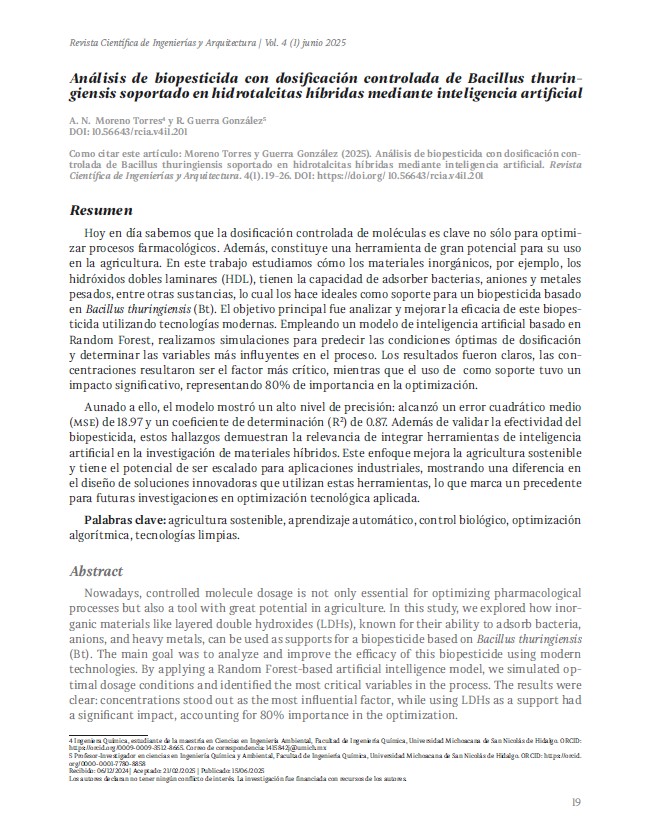An ANALYSIS OF A BIOPESTICIDE WITH CONTROLLED DOSAGE OF BACILLUS THURINGIENSIS SUPPORTED ON HYBRID HYDROTALCITES USING ARTIFICIAL INTELLIGENCE.
DOI:
https://doi.org/10.56643/rcia.v4i1.201Keywords:
algorithmic optimization, biological control, clean technologies, machine learning, sustainable agricultureAbstract
Nowadays, controlled molecule dosage is not only essential for optimizing pharmacological processes but also a tool with great potential in agriculture. In this study, we explored how inorganic materials like layered double hydroxides (LDHs), known for their ability to adsorb bacteria, anions, and heavy metals, can be used as supports for a biopesticide based on Bacillus thuringiensis (Bt). The main goal was to analyze and improve the efficacy of this biopesticide using modern technologies. By applying a Random Forest-based artificial intelligence model, we simulated optimal dosage conditions and identified the most critical variables in the process. The results were clear: concentrations stood out as the most influential factor, while using LDHs as a support had a significant impact, accounting for 80% importance in the optimization. Additionally, the model achieved high precision, with a mean squared error (MSE) of 18.97 and a coefficient of determination (R2) of 0.87. These findings not only validate the biopesticide’s effectiveness but also highlight the importance of integrating artificial intelligence into hybrid material research. This approach enhances sustainable agriculture and opens the door to scaling these solutions for industrial applications, setting a foundation for future innovations in technological optimization.
References
Askeland, D. R., y Fulay, P. P. (2017). Estructuras cristalinas de materiales. En Ciencia e Ingeniería de los materiales (6ª ed., pp. 60-86). Cengage Learning.
Benítez Aguilar, A., Velázquez Cigarroa, E., y Márquez Molina, O. (2023). Análisis de modelos de producción local para la sostenibilidad y seguridad alimentaria en el Estado de México. En Castro Martínez, O. R., y Fontalvo Buelvas, J. C. (Eds.), Agricultura, huertos educativos y transformaciones socioecológicas: Experiencias significativas en México (pp. 15-34). SIEA.
Bravo, A., Gill, S. S., y Soberón, M. (2007). Mode of action of Bacillus thuringiensis Cry and Cyt toxins and their potential for insect control. Toxicon, 49(4), 423-435. https://doi.org/10.1016/j.toxicon.2006.11.022
Breiman, L. (2001). Random Forests. Machine Learning, 45(1), 5-32. https://doi.org/10.1023/A:1010933404324
Cardoso, L., y Valim, J. (2006). Study of acids herbicides removal by calcined Mg-Al-CO3-LDH. Journal of Physical Chemistry of Solids, 67, 987-993. https://doi.org/10.1016/j.jpcs.2006.02.039
Caswell, T. A., Droettboom, M., Lee, A., Hunter, J., Firing, E., Nielsen, J., Elson, P., Seppänen, J. K., Dale, D., y Varoquaux, N. (2021). Matplotlib: Visualization with Python. Zenodo. https://doi.org/10.5281/zenodo.4559847
Castillo López, E., Muñoz Osorio, G. A., López Tolentino, G., y Marín Colli, E. E. (2024). Evaluation of different doses of chemical fertilization on growth and yield of creole pepper “Xkat iik” (Capsicum annuum L.). Revista Chapingo Serie Agricultura Tropical, 4(1). https://doi.org/10.5154/r.rchsat.2023.04.03
Chaara, D., Pavlovic, I., Bruna, F., Ulibarri, M., y Barriga, C. (2010). Removal of nitrophenol pesticides from aqueous solutions by layered double hydroxides and their calcined products. Applied Clay Science, 50, 292-298. https://doi.org/10.1016/j.clay.2010.07.007
Duraisamy, K., et al. (2023). Development of a new broad-spectrum microencapsulation-based spray drying formulation of Bacillus thuringiensis. Frontiers in Microbiology. https://doi.org/10.3389/fmicb.2023.1273725
EPA (Environmental Protection Agency). (1998). Reregistration Eligibility Decision (RED) for Bacillus thuringiensis. Office of Prevention, Pesticides and Toxic Substances.
Fu, Y., Fu, X., Song, W., Li, Y., Li, X., y Yan, L. (2023). Recent progress of layered double hydroxide-based materials in wastewater treatment. Materials, 16(16), 5723. https://doi.org/10.3390/ma16165723
Glare, T. R. (2000). Bacillus thuringiensis: Biology, ecology, and safety. Springer. https://doi.org/10.1007/978-94-011-4010-2
Harris, C. R., Millman, K. J., Van der Walt, S. J., Gommers, R., Virtanen, P., Cournapeau, D., Wieser, E., Taylor, J., Berg, S., Smith, N. J., Kern, R., Picus, M., Hoyer, S., Van Kerkwijk, M. H., Brett, M., Haldane, A., Del Río, J. F., Wiebe, M., … Oliphant, T. E. (2020). Array programming with NumPy. Nature, 585(7825), 357-362. https://doi.org/10.1038/s41586-020-2649-2
Ho, T. K. (1995). Random Decision Forests. Proceedings of the 3rd International Conference on Document Analysis and Recognition, 278-282. https://doi.org/10.1109/ICDAR.1995.598994
Miyata, S. (1983). Anion-exchange properties of hydrotalcite-like compounds. Clays and Clay Minerals, 31(4), 305-311. https://doi.org/10.1346/CCMN.1983.0310406
Pedregosa, F., Varoquaux, G., Gramfort, A., Michel, V., Thirion, B., Grisel, O., Blondel, M., Prettenhofer, P., Weiss, R., Dubourg, V., Vanderplas, J., Passos, A., Cournapeau, D., Brucher, M., Perrot, M., & Duchesnay, E. (2011). Scikit-learn: Machine Learning in Python. Journal of Machine Learning Research, 12, 2825-2830.
Talkhan, F. N., et al. (2023). Influence of some environmental conditions on stability and activity of Bacillus thuringiensis formulations. Egyptian Journal of Biological Pest Control. https://doi.org/10.1186/s41938-018-0064-x
Vayssieres, L. (2009). On the tailored assembly of nano-objects into integrated systems: A multiple scale approach. Journal of Advanced Functional Materials, 19(5), 688-697. https://doi.org/10.1002/adfm.200800968
Waskom, M. (2021). Seaborn: Statistical Data Visualization. Journal of Open Source Software, 6(60), 3021. https://doi.org/10.21105/joss.03021

Downloads
Published
Issue
Section
License
Copyright (c) 2025 Aldara Natalya Moreno Torres, Roberto Guerra González

This work is licensed under a Creative Commons Attribution 4.0 International License.
Los autores/as que publiquen en esta revista aceptan las siguientes condiciones:
- Los autores/as conservan los derechos de autor y ceden a la revista el derecho de la primera publicación, con el trabajo registrado con la licencia de atribución de Creative Commons 4.0, que permite a terceros utilizar lo publicado siempre que mencionen la autoría del trabajo y a la primera publicación en esta revista.
- Los autores/as pueden realizar otros acuerdos contractuales independientes y adicionales para la distribución no exclusiva de la versión del artículo publicado en esta revista (p. ej., incluirlo en un repositorio institucional o publicarlo en un libro) siempre que indiquen claramente que el trabajo se publicó por primera vez en esta revista.
- Se permite y recomienda a los autores/as a compartir su trabajo en línea (por ejemplo: en repositorios institucionales o páginas web personales) antes y durante el proceso de envío del manuscrito, ya que puede conducir a intercambios productivos, a una mayor y más rápida citación del trabajo publicado.








